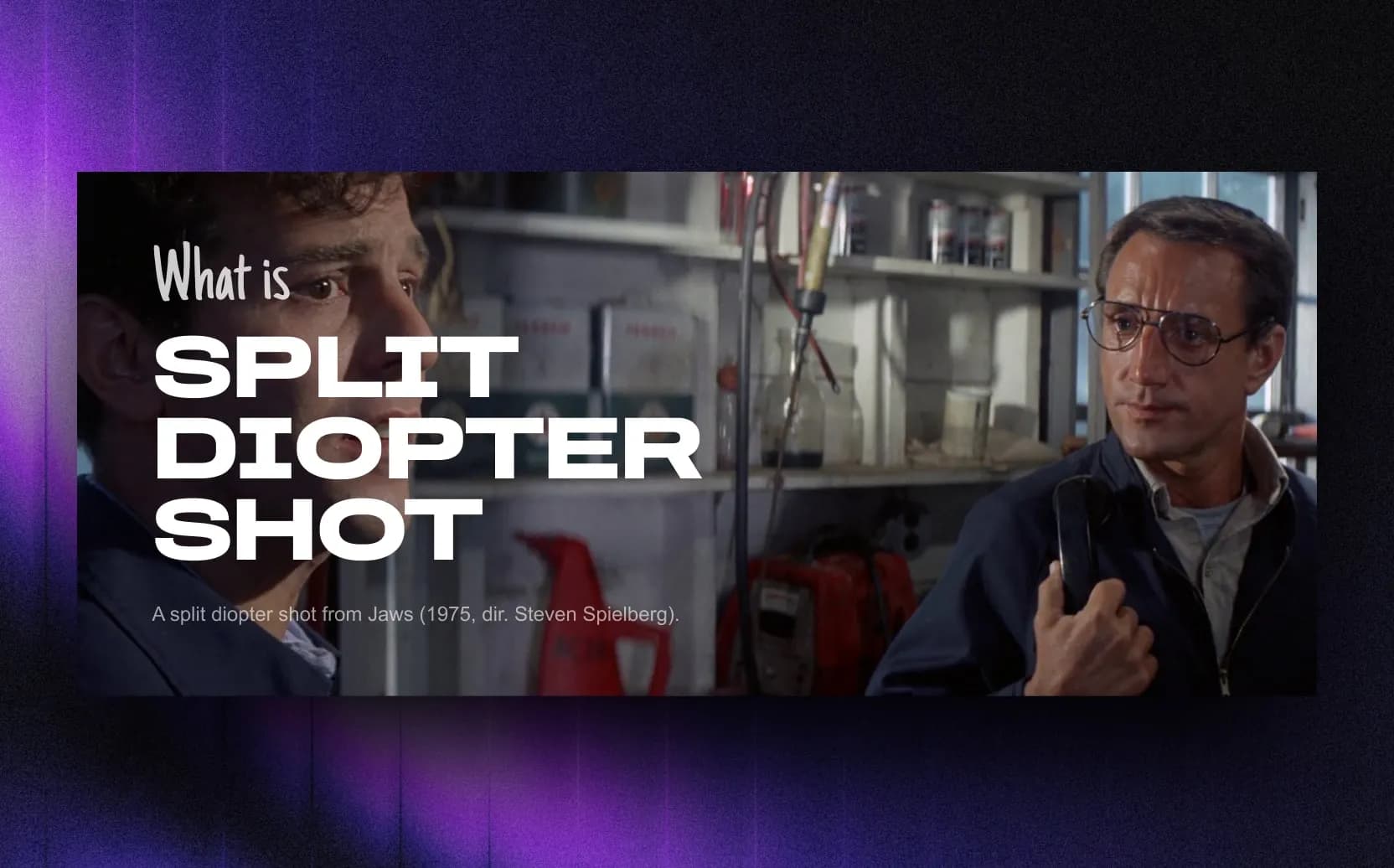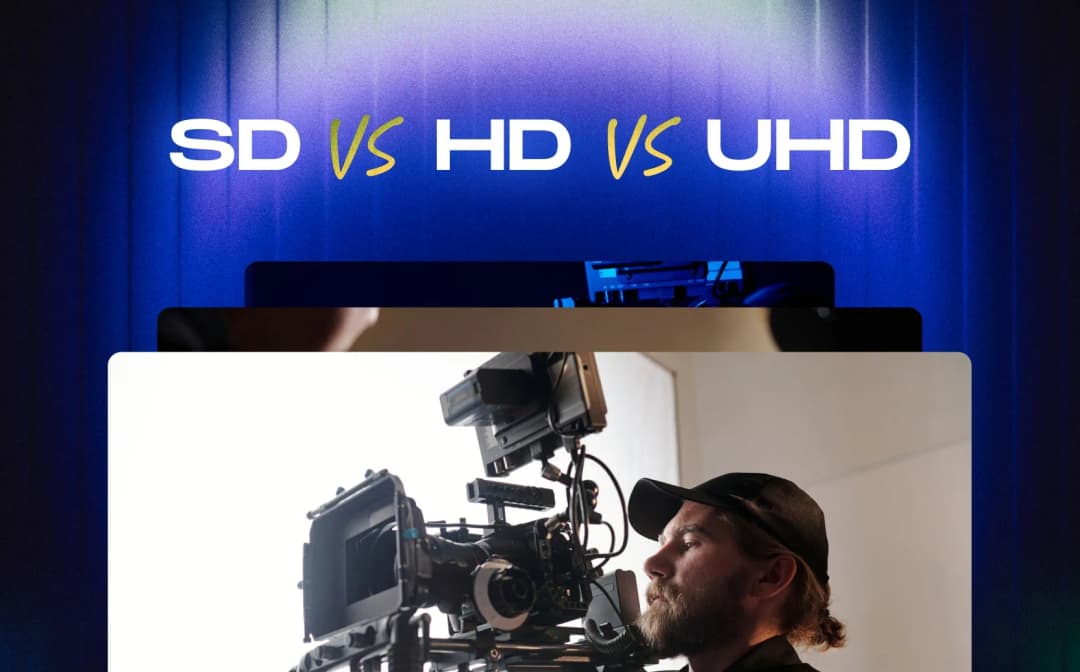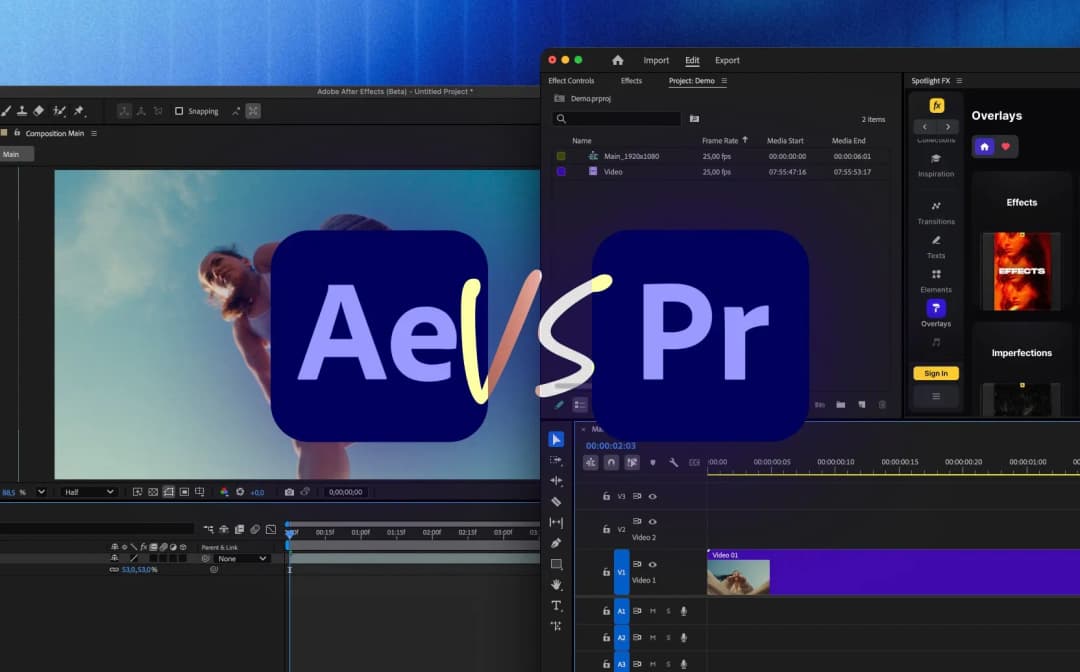What is a Split Diopter Shot? Cinematography Technique Explained
|
13 mins
|
Updated on May 12, 2025

- TL;DR: What You Should Know About Split Diopter Shots
- What is a Split Diopter Lens?
- How Does a Split Diopter Shot Work?
- Why Use a Split Diopter Shot?
- Split Diopter vs. Deep Focus
- How to Achieve a Split Diopter Shot
- Examples of Split Diopter Shots in Film
- Challenges of Using a Split Diopter
- Final Thoughts
- Spotlight FX - Get free transitions, effects and workflow tools
A split diopter shot is a cinematic technique using a special lens attachment to keep subjects in both the foreground and the background simultaneously in sharp focus, while the area between them may be blurred. This creates a distinct visual effect where two separate planes of action or points of interest share the screen with equal clarity.
TL;DR: What You Should Know About Split Diopter Shots
If you’re short on time, here are quick answers to the most common questions about split diopter shots in film:
What is a split diopter shot?
It’s a cinematography technique that keeps both the foreground and background in sharp focus using a split-field lens, while the middle area may remain blurred. It allows two separate planes of action to be shown clearly in the same frame.
Why is split diopter rarely used?
It’s difficult to use well. The dividing line between focus planes can be distracting if not hidden carefully, and camera movement becomes tricky. It also creates an unnatural look that can feel forced without strong story motivation.
What is the difference between split diopter and deep focus?
Deep focus keeps everything in sharp focus using aperture, lens choice, and lighting. A split diopter uses a lens filter to focus only the near and far planes, often leaving the middle blurry and showing a visible transition line between the two.
How to use split diopter filter?
Attach the split diopter to your lens, then carefully compose your shot with subjects placed in foreground and background zones. Align the dividing line with objects like door frames or furniture to hide it, and keep the camera still to maintain the effect.
What is a Split Diopter Lens?
The effect is achieved using a split diopter lens (or more accurately, a split-field close-up lens). This isn't a complete lens itself, but rather an auxiliary lens element, typically a convex glass segment, that covers only part (usually half) of the camera's primary lens.
Think of a standard diopter, which is a simple lens used for close-up photography, reducing the minimum focusing distance of the main lens. A split diopter is essentially half of one of these close-up lenses mounted in a ring. When attached to the front of the camera lens, the split diopter affects only the part of the image seen through it, magnifying that portion slightly and shifting its focal plane closer to the camera. The other half of the image, viewed through the uncovered portion of the main lens, retains the original focal properties of that lens.
So, the term "split diopter lens" refers to this attachment that modifies the behavior of the existing camera lens to create the split focus effect.
How Does a Split Diopter Shot Work?
The mechanics behind the split diopter shot rely on creating two distinct focal planes within the same frame.
- Partial Lens Coverage: The split diopter attachment covers only a section of the main camera lens.
- Foreground Focus Shift: The diopter segment (the half-lens) magnifies and brings the focal point much closer for the part of the scene it covers. This allows an object very near the camera, on one side of the frame, to be in sharp focus.
- Background Focus: The uncovered portion of the main lens focuses independently, typically set to capture a subject or area much farther away in the background, keeping it sharp.
- The Dividing Line: Because there are two different focal planes created by the covered and uncovered parts of the lens, a line exists where these two distinct fields of focus meet. This line often appears as a slightly blurred or out-of-focus vertical or horizontal zone running through the middle of the image, depending on the orientation of the split diopter. Cinematographers often try to camouflage this line using vertical or horizontal elements within the scene composition, such as door frames, pillars, or edges of furniture.
Essentially, the split diopter forces the camera to see in two different focus distances at once, dividing the frame into separate zones of sharpness.
Why Use a Split Diopter Shot?
Filmmakers employ the split diopter shot for specific narrative and aesthetic purposes. It's a stylistic choice that draws attention to itself, unlike more conventional focusing techniques.
- Creating Tension: By showing two subjects in different planes of depth with equal clarity, the shot can create a sense of unease or foreshadowing. The viewer is forced to acknowledge both the foreground and background action simultaneously, which can imply a connection, a conflict, or a hidden danger. For instance, a character in the foreground might be unaware of a threat lurking in the background, but the audience sees both clearly.
- Linking Characters or Objects: The shot can visually connect two characters or a character and an object across significant distances within the frame. This can emphasize their relationship, whether it's one of opposition, connection, surveillance, or thematic relevance. It forces the viewer to consider both elements in relation to each other.
- Maximizing Information: In certain scenes, a director might want to convey multiple pieces of visual information concurrently without cutting or racking focus. The split diopter allows distinct actions or points of interest in different spatial planes to be presented clearly within a single composition.
- Subjectivity: It can sometimes reflect a character's heightened state of awareness or a fractured psychological state, where different elements of their environment are perceived with unnatural clarity.
- Stylistic Flair: Certain directors, like Brian De Palma, are known for their frequent use of the split diopter shot as part of their signature visual style. It creates a unique, sometimes unsettling, look that deviates from standard depth-of-field conventions.
The decision to use a split diopter shot meaning is often tied to enhancing the scene's psychological impact or narrative complexity by manipulating focus in a non-traditional way.
Split Diopter vs. Deep Focus
While both split diopter shots and deep focus shots aim to keep multiple planes of the image sharp, they achieve this through different means and produce distinct visual results.
- Deep Focus: Deep focus cinematography achieves extensive depth of field, meaning a large portion of the image, from the near foreground to the distant background, is rendered in sharp focus. This is typically accomplished using:
- Wide-angle lenses.
- A small aperture (high f-number), which increases the depth of field but requires more light.
- Sufficient lighting to compensate for the small aperture. Deep focus creates a continuous, sharp view throughout the depth of the scene, allowing the viewer's eye to roam freely between foreground, middle ground, and background elements, all rendered clearly. A classic example is found in Orson Welles' Citizen Kane.
- Split Diopter Shot: A split diopter shot creates two distinct planes of sharp focus (one very close, one farther away) using the lens attachment. Unlike deep focus, it doesn't necessarily render the entire space between these two planes sharply. In fact, the area between the close foreground subject and the distant background subject is often noticeably out of focus. Crucially, the split diopter introduces the characteristic dividing line or blurred zone where the two fields meet.
Key Differences Summarized:
Features | Split Diopter Shot | Deep Focus Shot |
|---|---|---|
Mechanism | Partial lens attachment | Lens choice, small aperture, lighting |
Focus Planes | Two distinct, separate planes | Continuous large depth of field |
Middle Ground | Often blurred | Typically in focus |
Dividing Line | Visible blurred transition zone | No inherent dividing line |
Lens Used | Any lens + split diopter filter | Often wide-angle lenses |
Lighting | Less dependent on intense light | Often requires significant light |
In essence, deep focus provides expansive, continuous clarity, while a split diopter provides selective, divided clarity across two specific distances.
How to Achieve a Split Diopter Shot
Executing a successful split diopter shot requires careful planning and technical execution. Here’s how to do a split diopter shot:
- Obtain a Split Diopter Filter: These filters come in various strengths (like +1/2, +1, +2, +3) indicating the degree of magnification and focus shift for the close-up portion. They also come in different sizes to match the diameter of the camera lens.
- Choose Lens and Composition: While usable with various focal lengths, split diopters are often paired with lenses that aren't extremely wide or telephoto. The composition is critical. Plan the shot so that important elements fall clearly into the two distinct focal planes (near and far).
- Position the Filter: Attach the split diopter filter to the front of the main lens. It can usually be rotated. The orientation (vertical, horizontal, or diagonal) depends on the desired composition and how the foreground and background elements are arranged.
- Find the Dividing Line: Look through the viewfinder or monitor to identify the dividing line created by the edge of the diopter. This blurry transition needs to be managed.
- Camouflage the Line: This is crucial for a seamless effect. Position the camera and arrange elements in the scene so the dividing line aligns with existing vertical or horizontal lines in the environment. Good candidates include:
- Door frames
- Window edges
- Pillars or posts
- Corners of walls
- Edges of furniture
- Strong horizon lines If the line cannot be perfectly hidden, placing it in an area of low visual interest or complex texture can help make it less obvious. - Set Focus for Both Planes: This requires careful adjustment.
- Focus the main lens (the uncovered part) on the background subject until it is sharp.
- Check the foreground subject (seen through the diopter). Due to the diopter's effect, it should be sharp at a much closer distance. Adjust the camera's position or the subject's position slightly to achieve sharp focus on both simultaneously. Precise focus pulling might be needed if there's movement. - Control Aperture and Lighting: While a split diopter reduces the need for extremely small apertures (like deep focus), aperture still affects depth of field within each focal plane. A moderately small aperture (e.g., f/5.6, f/8) can help increase the sharpness range slightly around the chosen focal points. Lighting should illuminate both the foreground and background elements appropriately. Sometimes, lighting needs to be adjusted specifically to minimize the visibility of the dividing line.
- Minimize Movement (Often): Camera movement, especially panning or tilting, can be tricky with a split diopter because it can expose the dividing line or cause elements to shift awkwardly between the two focal planes. Static shots or very controlled movements are more common.
Examples of Split Diopter Shots in Film
The split diopter shot has been used memorably by many directors. Brian De Palma is particularly noted for his frequent and often dramatic use of this technique.
- Brian De Palma Films:
- Blow Out (1981): De Palma uses the split diopter shot extensively. A notable example involves John Travolta's character in the foreground working with audio equipment while Nancy Allen's character is visible and in focus through a window or doorway in the background, emphasizing their connection or the plot unfolding simultaneously in different spaces. The Blow Out split diopter shots often heighten suspense.
- Carrie (1976): The split diopter shot is used to create unease and highlight character dynamics, for instance, showing Carrie in one plane and her oppressors or the looming threat of the prom night disaster in another. The Carrie split diopter shots contribute significantly to the film's tense atmosphere.
- Dressed to Kill (1980): De Palma uses the technique to build suspense and visually link characters and potential threats across different planes of depth within the frame. - Jaws (1975): Directed by Steven Spielberg, Jaws features famous split diopter shots. One iconic example shows Police Chief Brody (Roy Scheider) on the phone in the foreground, occupying one side of the frame, while the background action unfolds clearly on the beach or the sea on the other side. This Jaws split diopter shot composition emphasizes Brody's isolation and the constant, looming threat from the ocean, even during mundane moments.
- All the President's Men (1976): Director Alan J. Pakula and cinematographer Gordon Willis used deep focus and occasionally split diopter effects to convey the vastness of the newsroom and the simultaneous activities occurring, placing reporters Bernstein (Dustin Hoffman) and Woodward (Robert Redford) within this larger context.
- Toy Story 4 (2019): Even animation utilizes this technique for effect. There's a notable split diopter shot in Toy Story 4 where Woody is in the foreground looking concerned, while Forky is clearly visible in the background, further away but equally in focus, emphasizing Woody's anxiety about the newly created toy. This Toy Story 4 split diopter shot mimics the live-action technique effectively.
- Us (2019): Jordan Peele employs a split diopter shot in Us. An example involves showing a character reacting in the foreground while their menacing "tethered" counterpart stands sharply in focus in the background, creating a direct visual link and palpable tension. The Us split diopter shot enhances the film's horror elements.
- Severance (TV Series, 2022): The distinctive visual style of Severance occasionally uses shots reminiscent of the split diopter effect, often placing characters in sterile office environments where foreground and background elements (like another character down a long hallway) are held in sharp focus to create unease or emphasize psychological division. The Severance split diopter shots fit the show's theme of duality.
- Challengers (2024): This film reportedly uses split diopter shots, likely to emphasize the intense relationships and rivalries between the main characters, possibly showing two players on court in focus simultaneously or linking a character's reaction in the foreground to action happening elsewhere. The Challengers split diopter shot would serve to heighten the dramatic tension.
The first split diopter shot is difficult to pinpoint definitively, as lens experimentation occurred throughout early film history, but its prominent use emerged more noticeably in the mid-20th century and became a recognized technique, especially from the 1970s onwards.
Challenges of Using a Split Diopter
While powerful, the split diopter shot presents several challenges:
- The Dividing Line: As mentioned, the transition between the two focal planes creates a noticeable blur or line. Hiding this line convincingly within the composition is often the biggest hurdle. If not masked well, it can look artificial and distract the viewer. A horizontal split diopter shot might use a tabletop or horizon line, while a vertical one might use a doorway.
- Unnatural Look: The effect inherently breaks the natural way human vision perceives depth and focus. This can sometimes pull viewers out of the film if not used judiciously or if the effect appears too forced.
- Restricted Movement: Camera movements like panning, tilting, or complex dolly shots can easily reveal the dividing line or make the perspective shifts jarring. This often limits the technique to static or very carefully controlled shots.
- Compositional Constraints: The need to place subjects precisely in the two focus zones and align the dividing line with scenic elements can heavily restrict compositional choices.
- Focus Pulling: Achieving and maintaining focus on moving subjects in both planes simultaneously can be extremely difficult for the camera assistant.
The split focus diopter shot, or split field diopter shot, requires deliberate intent and technical skill to overcome these challenges and achieve the desired narrative or visual impact. It's a tool that, when used effectively, can create uniquely compelling images, but when used poorly, can feel clumsy or artificial.
Final Thoughts
The split diopter shot is a specialized cinematography technique that uses a partial lens attachment to create two distinct planes of sharp focus within a single frame, typically one in the near foreground and one in the distant background. It differs from deep focus, which aims for continuous sharpness throughout the depth of the scene.
Filmmakers use this technique to generate tension, visually link characters or objects across space, present multiple pieces of information simultaneously, or achieve a specific stylistic effect. Directors like Brian De Palma have famously incorporated it into their visual language. While powerful, successfully executing a split diopter shot requires careful planning to camouflage the inherent dividing line between the focal planes and manage potential technical challenges.
For further exploration of related techniques, consider researching deep focus cinematography or the use of different lens types in visual storytelling. Understanding how focus and depth of field are manipulated is fundamental to appreciating the art of filmmaking.
Denis Stefanides
About the author
Updates
- May 12, 2025 - Added a TL;DR section summarizing how split diopter shots work and why they're used in filmmaking.
Related Posts

Denis Stefanides
5 mins

Denis Stefanides
11 mins

Denis Stefanides
10 mins
